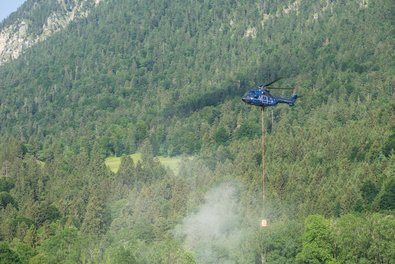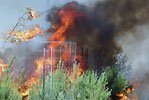When we think of huge forest fires, it is usually the fires in California, Canada, Southern Europe that come to mind, or most recently the fire in Chile, in which several thousand hectares were destroyed within a very short time. With its extremely hot and dry summer, the year 2022 also showed us, however, that large fires can also occur on our own doorstep. In Bavaria, there were 145 fires, over a total area of 214 ha. We must be particularly vigilant and exercise great care if we are to prevent forest fires.
After a wet year in 2021, with very few forest fires, several major fires in eastern Germany in 2022 brought the issue of forest fires back to mind. There were several huge fires, some of which made waves nationwide in the media. The most prominent was the forest fire in the “Sächsische Schweiz” (“Saxon Switzerland”) National Park, which consumed an area of 115 ha on the German side of the border with the Czech Republic. The neighbouring “Böhmische Schweiz” (“Bohemian Switzerland”) National Park on the Czech side was hit even harder. Here, around 1100 hectares or 14% of the national park area burned.
One of the largest forest fires in Germany in 2022 was reported on the border between Saxony and Brandenburg, in the Gohrischheide, and covered 905 hectares. Also imprinted on our memories are pictures of the forest fire on the Brocken mountain in the Harz National Park, where even fire-fighting aircraft from Italy were deployed.
Many of these large fires had things in common. In addition to the favourable conditions for forest fires, such as dry, hot weather and the availability of sufficient combustible biomass, the site of the fire was unfavourable for extinguishing measures: either because the site was difficult to access, as in the Saxon Switzerland National Park, or because the area was contaminated with explosive ordnance (Gohrischheide), so that the emergency services were unable to enter the area, and extinguishing measures were only possible from a safe distance of at least 500 m.
Significantly more fires in Bavaria than on average
In Bavaria, forest fire prevention and control worked well in 2022. Although there were significantly more fires than in normal years, the local fire brigades were always quickly able to prevent larger vegetation fires taking hold. With a forest fire area of 2 ha, a forest fire near Küps in Upper Franconia on 26 July 2022 was one of the larger fires in the country.
The statistics for 2022 recorded 145 fires, an increase of 53% compared to the long-term average (78 fires/year). Bavaria is thus in line with the trend of other federal states such as Brandenburg (500 fires: +40%). In total, an area of 214 ha burned in Bavaria, which is 3.5 times more than the long-term average and a new record for Bavaria since 1991. Up to this point, the area of 205 hectares that burned in 2003, the first great hot summer, was the record holder.
Why was such a large area affected, even though our fire brigades actually got many fires under control in time? In the federal forest, i.e. the large military training areas, 30 fires brought the area affected to a total of 189 ha. The federal forest has a share of just 2% of the forest area in Bavaria, but a share of 88% of the burnt area. In the past, too, it accounted for as much as 53% of fires and 40% of the forest fire area (1993 - 2021). On the military training grounds, on the other hand, the professional fire brigades of the participating nations fight the forest fires caused by military training operations very effectively. The fires occurred mainly as a result of military training operations, and were particularly concentrated on the so-called impact area, which serves as a target area for projectiles.
In Bavaria, too, there were fairly large fires (>10 ha) outside the military training areas. Here too, we have inaccessible areas where, given the right conditions (e.g. dry vegetation), larger areas can be affected. The Alps in particular should be mentioned here, where several major forest fires have occurred in the past. Because of the difficult accessibility, relatively large fires are more likely.
Well remembered are the fires on the Antoniberg mountainside near Bad Reichenhall (40 ha) in April 2007, or on the Jochberg mountain near Kochel in the winter of 2016 (27 ha), which was caused by a campfire that got out of control. But even far from the Alps - in the low mountain ranges, for example - major fires have been known to rage. In April 2012, an area of 12.4 ha of mixed forest on a steep red sandstone slope in the Bavarian part of the Odenwald forest near Amorbach burned. In order to avoid such situations as far as possible in future, forestry and fire services are increasingly preparing for them.


Figs. 2 and 3: In Bavaria, forest fire prevention and control worked well in 2022. Left: Fire engines at a helicopter landing pad, right: a transport helicopter with fire-fighting water tank fighting a forest fire. Photos: Michael Friedel
Preventing fires: everyone is called upon
But the population can also do its part to prevent forest fires. The cause of most forest fires is human. According to the EU Forest Fire Report (ECJRC 2021), as many as nine out of ten fires can be attributed to human activity; through deliberate or negligent actions. The perpetrators of such fires caused by negligence range from forest visitors to forest owners. It is therefore up to each individual to be especially careful during dry periods.
When visiting the forest during such times, you should use the designated parking areas. When you park in tall grass, you should be aware that a hot catalytic converter may ignite dry grass, and cause a fire. Smoking in the forest is also very dangerous, which is why it is prohibited from 1 March to 31 October (cf. §17 Bavarian Forest Law BayWaldG). Fires of any kind are prohibited in the forest all year round, as they pose a great danger, especially in dry periods (§17 BayWaldG).
Do not underestimate the risk of forest fires
Especially in summer when the weather is very dry, you should also think carefully about whether it is absolutely necessary to make a campfire on public barbecue sites near the forest, even if it is officially permissible at the time. Especially in spring, the danger of forest fires should not be underestimated. Because the trees are not yet in leaf at the beginning of the year, the sun's rays can reach the forest floor unhindered. A lot of dry leaves, dead brushwood from the winter or grasses are then particularly flammable.
Forest owners, for example, are in fact exempt from the fire ban (cf. §17, para. 4 BayWaldG). But here, too, caution should be the top priority. The burning of logging residues should be avoided, especially in periods when there is a high risk of forest fire. Despite precautions, again and again there have been cases when a forest fire has developed from this. If the danger is particularly high, the municipalities also have the option of significantly restricting the use of fire in the municipal area. In the course of forestry work, timber harvesters may for example also cause sparks to fly. Precautionary measures such as the keeping to hand of a fire extinguisher or small amounts of water are recommended to prevent a fire from developing.
Raising awareness among the population
In many countries there are nationwide campaigns to raise awareness among the population. The most prominent example is probably to be found in the United States and Canada, where the mascot "Smokey the bear" passes on rules of conduct. This mascot can be found on warning signs next to roads, at campsites, and at the entrances to national parks, among other places. Since most citizens associate this symbol with the rules of conduct, they remember these immediately when they see it.
In Germany, there are currently efforts to introduce a nationwide campaign. In eastern Germany, especially in the 1990s, the forest fire squirrel with the fiery tail was used for this purpose. It had a decades-long tradition there. The Bavarian Forestry Administration and the Offices of Food, Agriculture and Forestry are also putting a focus in 2023 on the topic of forest fires and on raising awareness, with a wide range of activities such as information events, further training and practical forest fire exercises in cooperation with local fire brigades.





![[Translate to English:] [Translate to English:]](/assets/_processed_/7/b/csm_fva_waldbrand_wb5_sensor_7c36a89bab.jpeg)
